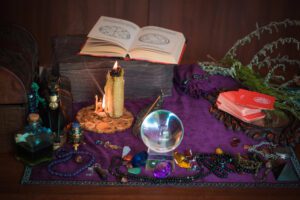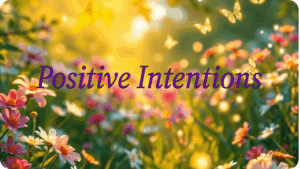The Woman Who Saw Dragons in the Clouds
Sarah stood transfixed at her office window while her colleagues rushed past, oblivious to what had captured her attention. Outside, clouds twisted into magnificent shapes—one particularly striking formation resembled a dragon in flight, its vapor wings stretching across the azure canvas. She pointed it out to her coworker Mark, who glanced up momentarily, shrugged, and returned to his spreadsheet. “Just clouds,” he muttered.
In that brief exchange lies a fundamental truth about human perception: we don’t all experience the world the same way. Some of us, like Sarah, move through life attuned to moments of everyday enchantment—finding faces in electrical outlets, meaning in coincidences, and stories in the patterns of our daily lives. Others, like Mark, operate with ruthless practicality, seeing only facts, functions, and physics—nothing more.
Neither approach is inherently right or wrong, but this perceptual divide shapes everything from our happiness levels to our creative output, relationships, and careers. The capacity to perceive magic—that sense of wonder, mystery, and enchantment in ordinary experiences—isn’t merely about whimsy. It represents a fundamental orientation toward existence that neuroscience is only beginning to understand.
What separates those who see the extraordinary within the ordinary from those who don’t? And more importantly, can we choose which side of this invisible divide we stand on?
The Desensitized Mind: Living in a World Without Wonder
For many adults, the world appears reliably predictable. The sunset is merely the rotation of the Earth. The forest is an ecosystem of competing organisms. Coincidences are statistical inevitabilities. This perspective isn’t wrong—it’s incomplete. The state of wonder-blindness affects countless individuals who once possessed the natural capacity for enchantment but have since lost touch with it.
Dr. Rachel Levinson, a cognitive psychologist specializing in adult perception, explains: “Many of my patients describe a kind of perceptual flatness—a sense that the world lacks depth or meaning beyond its utilitarian functions. They remember feeling differently as children but can’t access that state anymore. It’s as though they’re looking at life through a dirty window.”
This condition—what we might call “wonder blindness”—rarely arrives all at once. Instead, it develops gradually through cultural conditioning, educational emphasis on analytical thinking, and accumulating life responsibilities. We become trained to value efficiency over exploration, certainty over mystery, and practical outcomes over meaningful experiences.
The costs of this perceptual narrowing extend beyond mere enjoyment. Research from the University of Pennsylvania found that individuals who score low on “awe proneness” measurements report higher stress levels, lower satisfaction with life, and decreased creative problem-solving abilities. When we lose access to wonder, we don’t just miss out on magical moments—we fundamentally alter our relationship with reality.
Consider Thomas, a 42-year-old accountant who sought therapy for persistent feelings of emptiness despite career success. “I remember being a kid and spending hours watching ants build their colonies, completely fascinated by their little world,” he told his therapist. “Now, I can’t remember the last time anything truly captivated me that way. Everything just feels…expected.”
Thomas represents millions trapped in what philosopher Max Weber called the “iron cage of rationality”—a mindset where everything must be categorized, explained, and controlled. This orientation toward life provides structure and predictability but often at the cost of vitality and meaning.
The Enchanted Perspective: Where Wonder Flourishes
On the other side of the perceptual divide stand those who experience what writer Elizabeth Gilbert calls “everyday magic”—individuals who maintain their capacity for wonder well into adulthood. These aren’t necessarily spiritual seekers or artistic types, though we often find them in those communities. They’re ordinary people who somehow preserved or recovered their ability to be captivated by the world.
Maya, a 67-year-old retired teacher, exemplifies this perspective. “I’ve never understood people who say they’re bored,” she laughs. “How can anyone be bored on a planet with over a million insect species, where light travels from stars that died before humans existed, and where music can make you cry without a single word? There’s so much we don’t understand—that’s the most exciting part.”
What sets people like Maya apart isn’t naiveté or a rejection of science. Research from Johns Hopkins University suggests that those with heightened capacities for wonder often have equally strong analytical abilities. The difference lies in cognitive flexibility—their ability to shift between different ways of seeing.
Dr. Jonathan Hayes, a neuroscientist studying states of awe and wonder, describes it this way: “Wonder-prone individuals demonstrate unique patterns of default mode network activity. They readily toggle between focused attention and ‘diffuse awareness’—a state where the brain makes broader, less predictable connections. They’re not sacrificing rationality but supplementing it with other forms of knowing.”
This integrated perception creates a fundamentally different lived experience. A wonder-attuned person might accurately understand the biological mechanics of a butterfly’s metamorphosis while simultaneously experiencing profound awe at the transformation. They simultaneously hold the scientific explanation and the sense of mystery—neither canceling out the other.
These individuals report higher levels of gratitude, stronger social connections, and a greater sense of meaning in life. They regularly experience what psychologist Abraham Maslow called “peak experiences”—moments of transcendent joy and connection that most people encounter only rarely.
The Neurological Basis of Wonder: How Our Brains Process Magic
The capacity for wonder isn’t merely philosophical—it has distinct neurological underpinnings. Functional MRI studies reveal that experiences of awe and wonder activate a complex interplay between the default mode network (associated with self-reflection), the salience network (which determines what deserves our attention), and regions involved in sensory processing.
Developmental psychologist Dr. Alison Gopnik explains that children naturally experience a “lantern consciousness”—an expansive, diffuse awareness that absorbs details adults typically filter out. “Children are little scientists and little poets all at once,” she writes. “They’re designed to learn through exploration and play, treating everything as potentially significant.”
This neurological openness helps explain why children so readily engage with magical thinking. A child who believes their stuffed animals have feelings or that whispered wishes might come true isn’t simply indulging in fantasy—they’re exhibiting the brain’s natural inclination toward finding meaning and connection.
As we age, most adults develop stronger “spotlight consciousness”—a focused, goal-oriented attention that filters out “irrelevant” details. This development has clear evolutionary advantages, helping us complete tasks efficiently and avoid distraction. However, this neurological shift comes with significant costs.
“What we’re discovering,” notes neuropsychologist Dr. Martin Seligman, “is that the brain’s filtration system, while necessary for adult functioning, often screens out precisely the information that triggers states of wonder and awe. We literally train ourselves not to see the extraordinary.”
Interestingly, certain conditions like synesthesia—where stimulation of one sensory pathway leads to experiences in another, such as “seeing” sounds or “tasting” shapes—correlate with a heightened capacity for wonder. Researchers believe these conditions reduce the brain’s natural inhibitory processes, allowing for more unusual connections between neural networks.
How Childhood Experiences Shape Our Magical Perception
Our orientation toward wonder or practicality begins in early childhood and is shaped by cultural messages, parental responses, and educational approaches. Children naturally possess magical thinking—the developmental stage where they believe their thoughts might influence reality, where objects have consciousness, and where coincidences hold special meaning.
Childhood development expert Dr. Elena Martinez observes: “How adults respond to a child’s magical thinking profoundly shapes their relationship with wonder. Parents who participate in this thinking—who help search for fairies in the garden or discuss what clouds might be dreaming about—validate an essential way of knowing the world. Parents who routinely dismiss these perspectives as ‘silly’ or ‘just imagination’ may unintentionally teach children to devalue their perceptual experiences.”
Educational systems also play a crucial role. Standard curricula typically emphasize analytical thinking while devaluing imaginative exploration. Students learn to categorize, measure, and explain rather than to marvel, connect, and wonder. By adolescence, many young people have internalized the message that serious minds focus on facts, not mysteries.
Consider the contrasting experiences of twins Emma and Jacob, who were raised in the same household but by different primary caregivers. Emma’s grandmother, her main daytime caregiver, regularly incorporated elements of folklore, nature observation, and imaginative play into their activities. Jacob, primarily cared for by his pragmatic father, was encouraged toward sports, mathematics, and logical reasoning.
By adulthood, the twins displayed markedly different orientations toward experience. Emma maintained her capacity for wonder, regularly noticing beautiful synchronicities and finding deep meaning in ordinary moments. Jacob, successful in his engineering career, often expressed confusion at his sister’s “fanciful” interpretations of everyday events. Neither perspective was superior, but they created vastly different lived experiences.
The Bridge: Reclaiming Your Capacity for Wonder
Suppose you recognize yourself in the wonder-blind category. In that case, there’s encouraging news: the capacity for enchantment isn’t permanently lost but merely dormant. Anyone can recover it, like any perceptual skill, through intentional practice. The following approaches may help someone reawaken dormant wonder:
1. Deliberate Attention Shifting
Neuroscientist Dr. Katherine Ellison recommends a practice she calls “perspective pivoting”—deliberately shifting between analytical and wonder-oriented attention. “When viewing a sunset, for instance, first observe it scientifically: note the atmospheric conditions creating the colors, the time of day, the season. Then, intentionally shift to experiencing the sunset as a moment of beauty and mystery. With practice, these shifts become more natural.”
This technique helps create new neural pathways that make wonder more accessible. Many formerly wonder-blind individuals report that after several weeks of regular practice, they begin experiencing spontaneous moments of awe without deliberate effort.
2. Sensory Immersion Practices
Wonder requires presence, yet many adults operate on autopilot. Mindfulness teacher Jon Kabat-Zinn suggests “sensory immersion” exercises to counter this tendency. Choose an ordinary experience—eating an orange, showering, walking to your car—and deliberately engage all your senses. Notice textures, sounds, scents, colors, and subtle sensations you typically overlook.
“The doorway to wonder is through the senses,” explains sensory integration specialist Dr. Maya Peterson. “When we fully inhabit our sensory experience, we naturally encounter the extraordinary within the ordinary. The problem isn’t that magic isn’t present—it’s that we’re not present to the magic.”
3. Cultivating Beginner’s Mind
Zen Buddhism offers the concept of “beginner’s mind”—approaching experiences without preconceptions, as though encountering them for the first time. This practice counteracts the brain’s tendency to categorize and dismiss familiar stimuli.
Former wonder-blind marketing executive David Marsden describes his experience: “I started asking myself simple questions about ordinary objects: What would this door handle look like if I’d never seen one before? How would I describe a cloud to someone who’d never seen the sky? These questions broke through my perceptual filters and revealed how extraordinary ordinary things actually are.”
4. Wonder Prompts and Wonder Walks
Environmental psychologist Dr. James Hamilton developed “wonder walks,” structured practices in which participants follow specific prompts designed to elicit states of curiosity and awe. Prompts include questions like “Find something older than human civilization,” “Discover a pattern you’ve never noticed before,” or “Locate something that connects to your personal history.”
“These prompts function as attention directors,” explains Hamilton. “They bypass our habitual filtration system and guide us toward aspects of reality that trigger wonder. With practice, people develop their own internal ‘wonder prompts’ that arise naturally during daily life.”
Transformation Stories: From Blindness to Sight
The journey from wonder blindness to enchanted perception often begins with a disruptive experience that temporarily suspends our usual ways of seeing. For software engineer Michael Chen, it was a near-fatal car accident that shifted his perception.
“Before the accident, I was completely focused on efficiency, productivity, and logical outcomes,” he recalls. “During my recovery, when I couldn’t work, I started watching birds outside my window—first out of boredom, then with increasing fascination. I noticed their social behaviors, their different calls, and their personalities. One day, I realized I was experiencing a kind of joy I hadn’t felt since childhood—this sense of being connected to something mysterious and alive.”
For others, the transformation comes through deliberate practice. Former banking executive Rebecca Turner describes her experience with a 30-day wonder challenge: “I committed to finding and documenting one ‘wonder moment’ each day. At first, it felt forced and silly. By week two, I struggled to choose just one moment to record. By the end of the month, I couldn’t understand how I’d ever found the world boring. The change in my perception was so profound that several colleagues asked if I’d fallen in love or started medication!”
These transformations affect more than just subjective experience. Research participants who engaged in eight-week wonder cultivation programs showed measurable changes in stress hormones, inflammatory markers, and heart rate variability. They reported improved relationships, enhanced creativity, and greater resilience during challenges.
“What’s most remarkable,” notes positive psychology researcher Dr. Vanessa King, “is how these perceptual shifts affect people’s behavior toward others. When you begin seeing the world as wonderful and mysterious, you naturally extend that perspective to human beings. People who cultivate wonder tend to become more compassionate, curious about different perspectives, and engaged with their communities.”
Finding Your Wonder Type: The Magic Perception Quiz
Wonder expresses itself differently across individuals. Understanding your natural “wonder type” can help you develop practices aligned with your perceptual tendencies. Consider which of these resonates most strongly with your experiences:
The Pattern Seeker
You find wonder in unexpected connections, synchronicities, and hidden patterns. Numbers, dates, and recurring symbols catch your attention. You might notice when the same unusual word appears three times in one day or find meaning in how events align in surprising ways.
The Beauty Attendee
Your wonder awakens through aesthetic experiences, the quality of light at certain times of day, the perfect symmetry of a flower, or the harmonies in music. Physical beauty serves as your primary doorway to a transcendent experience.
The Story Discoverer
You perceive narratives and characters everywhere. Ordinary objects hold histories that fascinate you. You wonder about the lives of strangers you pass and find yourself creating stories about how things came to be as they are.
The Cosmic Connector
Your sense of wonder activates when contemplating vast scales—the cosmos, evolutionary time, or microscopic worlds. You find enchantment in considering your place within something inconceivably larger or more complex than yourself.
Most people have elements of multiple types but tend toward one primary orientation. Recognizing your wonder type can help you choose practices that naturally align with your perceptual tendencies, making the journey back to enchantment more accessible.
The Balance: Magic Without Delusion
Cultivating wonder doesn’t require abandoning critical thinking or embracing pseudoscience. In fact, some of history’s most rigorous scientific minds maintained profound capacities for wonder. Albert Einstein famously noted that, “The most beautiful thing we can experience is the mysterious. It is the source of all true art and science.”
Cognitive scientist Dr. Helen Richards emphasizes that mature wonder differs from magical thinking: “Healthy adult wonder involves holding multiple perspectives simultaneously—understanding the mechanical explanation for something while still experiencing awe at its existence. We’re not advocating regression to childlike thinking but rather integration of analytical and wonder-oriented perspectives.”
This integration proves particularly valuable in creative fields. Award-winning architect Carlos Mendoza describes how wonder influences his work: “I need to understand structural engineering, materials science, and building codes with absolute precision. However, the buildings that move people come from a different kind of knowing—from seeing the magical possibilities within physical constraints. The best architects are simultaneously engineers and poets.”
The same principle applies across domains. Medical professionals who maintain their sense of wonder often demonstrate better diagnostic skills and patient relationships. Teachers who approach their subject matter with authentic curiosity inspire deeper student engagement. Business leaders who perceive the enchantment within ordinary processes create more innovative and humane workplaces.
Everyday Enchantment: Your Invitation to Wonder
The capacity to perceive magic in the mundane isn’t an exceptional talent granted to a lucky few—it’s a natural human ability that modern life often obscures. We can choose our relationship with reality by understanding the perceptual divide between wonder-blindness and enchanted seeing.
Begin with simple practices: spend five minutes daily in sensory immersion with an ordinary object. Take weekly wonder walks with specific attention prompts. Start a wonder journal documenting moments that awaken your curiosity or awe. Share your experiences with others, creating communities of practice that validate and strengthen this way of seeing.
Remember that the goal isn’t to reject rational understanding but to complement it with other ways of knowing. As philosopher Pierre Teilhard de Chardin wrote, “We are not human beings having a spiritual experience; we are spiritual beings having a human experience.” Our capacity for wonder connects us to both aspects of this truth.
Magic is all around us—the question is whether we have eyes to see it. For those willing to practice, the veil between ordinary and extraordinary grows increasingly thin, revealing that they were never truly separate.
What magical moment might be waiting for you today, hiding in plain sight?
Share Your Magic Moments
What everyday experiences fill you with wonder? Share your “magic moments” in the comments below. Has your perception of wonder changed throughout your life? What practices help you maintain or recover your sense of enchantment? Your stories might help others rediscover the magic in their own lives.
Important: This post is for informational and educational purposes only. This post should not be taken as [legal, financial, medical, therapy, etc.] advice or used as a substitute for such. You should always speak to your own [doctor, lawyer, CPA, therapist, nutritionist, etc.] before implementing this information on your own. Thank you!



